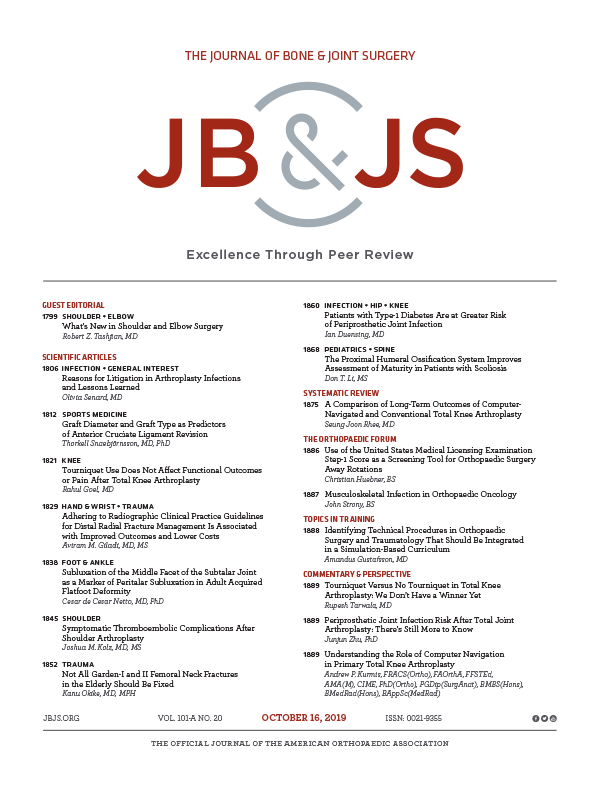
rhBMP-2 is safe and improves outcomes in open tibial fractures

rhBMP-2 is safe and improves outcomes in open tibial fractures
Recombinant human bone morphogenetic protein-2 for treatment of open tibial fractures: a prospective, controlled, randomized study of four hundred and fifty patients
J Bone Joint Surg Am. 2002 Dec;84-A(12):2123-34Did you know you're eligible to earn 0.5 CME credits for reading this report? Click Here
Synopsis
450 patients with an open tibial fracture were randomized to receive the standard of care with either intramedullary nail fixation and routine soft-tissue management (the control group), an implant containing 0.75 mg/mL of rhBMP-2 alongside the standard care, or an implant containing 1.50 mg/mL of rhBMP-2 alongside the standard care. The rhBMP-2 implant was placed over the fracture at the time of wound closure. At 12 months, the 1.50-mg/mL rhBMP-2 group had a 44% reduction in the risk of failure, significantly fewer invasive interventions and hardware failures, faster wound-healing and significantly faster fracture healing than the control patients. .
Was the allocation sequence adequately generated?
Was allocation adequately concealed?
Blinding Treatment Providers: Was knowledge of the allocated interventions adequately prevented?
Blinding Outcome Assessors: Was knowledge of the allocated interventions adequately prevented?
Blinding Patients: Was knowledge of the allocated interventions adequately prevented?
Was loss to follow-up (missing outcome data) infrequent?
Are reports of the study free of suggestion of selective outcome reporting?
Were outcomes objective, patient-important and assessed in a manner to limit bias (ie. duplicate assessors, Independent assessors)?
Was the sample size sufficiently large to assure a balance of prognosis and sufficiently large number of outcome events?
Was investigator expertise/experience with both treatment and control techniques likely the same (ie.were criteria for surgeon participation/expertise provided)?
Yes = 1
Uncertain = 0.5
Not Relevant = 0
No = 0
The Reporting Criteria Assessment evaluates the transparency with which authors report the methodological and trial characteristics of the trial within the publication. The assessment is divided into five categories which are presented below.
4/4
Randomization
4/4
Outcome Measurements
2/4
Inclusion / Exclusion
4/4
Therapy Description
4/4
Statistics
Detsky AS, Naylor CD, O'Rourke K, McGeer AJ, L'Abbé KA. J Clin Epidemiol. 1992;45:255-65
The Fragility Index is a tool that aids in the interpretation of significant findings, providing a measure of strength for a result. The Fragility Index represents the number of consecutive events that need to be added to a dichotomous outcome to make the finding no longer significant. A small number represents a weaker finding and a large number represents a stronger finding.
Why was this study needed now?
Open tibial fractures are associated with a high rate of complications, including delayed bone union and nonunion. Secondary interventions to promote union of open tibial fractures are associated with high rates of patient morbidity and reduced quality of life. Recombinant human bone morphogenetic protein-2 (rhBMP-2) has shown promise in animal and human studies as an osteoinductive agent and it is thought to have a positive role in improving union and reducing secondary interventions. This study was needed to assess the safety and efficacy of rhBMP-2 in the treatment of open tibial fractures.
What was the principal research question?
In patients with an open tibial fracture, what is the safety and efficacy of an rhBMP-2 implant based on dose and compared to standard of care alone over 12 months?
What were the important findings?
- The percentages of patients requiring secondary interventions for fracture healing were 26% and 37% in the higher and lower dose groups respectively, compared with 46% in the control group (p = 0.0004).
- The number and the invasiveness of these interventions were significantly lower in the higher dose group than in the control group (p=0.0326 for number and p=0.0264 for invasiveness).
- Among the higher dose group, there was a significant 44% reduction in the risk of secondary intervention compared with the control group (p=0.0005; relative risk=0.56; 95% confidence interval: 0.40-0.78).
- At 6 months, the healing rate observed in the higher dose group was 21% higher than that in the control group (p=0.0008). Kaplan-Meyer survival analysis indicated that the time to fracture healing was shorter in the higher dose group than in the control group (p=0.0022). This significance was not seen in the lower dose group.
- 32 patients (22%) in the control group had hardware failure compared with 16 patients (11%) in the higher dose group (p=0.0174).
- 83% of the patients in the higher dose group had soft-tissue healing 6 weeks after wound closure compared with 65% of the patients in the control group (p=0.0010).
What should I remember most?
rhBMP-2 shows a significant and dose-dependent effect on improving the rate of fracture and wound healing, and reducing the risks of secondary intervention and hardware failure in open tibial fractures over 12 months.
How will this affect the care of my patients?
Patients may benefit from an implant of rhBMP-2 along with standard care for open tibial fractures to reduce the risk of complications over 12 months and improve the rate of healing. Additional studies may be needed with longer-term follow-up and assessment of functional criteria.
Learn about our AI Driven
High Impact Search Feature
Our AI driven High Impact metric calculates the impact an article will have by considering both the publishing journal and the content of the article itself. Built using the latest advances in natural language processing, OE High Impact predicts an article’s future number of citations better than impact factor alone.
Continue



 LOGIN
LOGIN

Join the Conversation
Please Login or Join to leave comments.